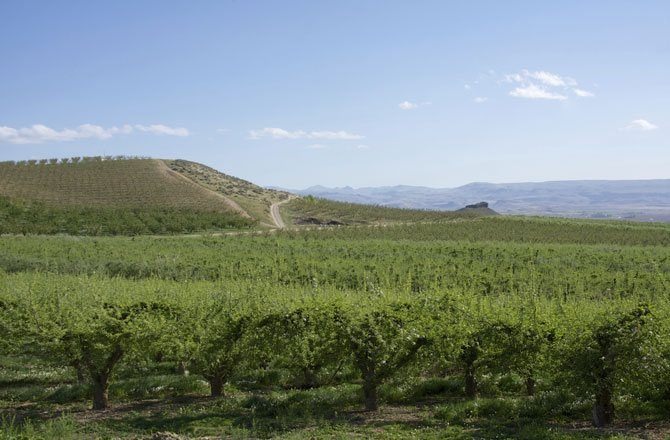Serious (And Sometimes Successful) Wines From Idaho
It's a tribute to the irresistible appeal of wine that people have tried to make it almost anywhere they find themselves. No soil is too poor, no climate too harsh. Fruit wine (from berries, stone fruit, and more) can be made almost anywhere, of course, but I'm talking about grape wine. If grapes will grow in a place, however tentatively, folks are going to pick them, crush them, and ferment them — besides all the regions we know about, there is wine (made from European grapes) in such places as Denmark, Namibia, and Thailand and Vietnam (I even know a guy who makes about 600 bottles a year from cabernet and merlot and a few other grapes in Ireland, for heaven's sake).
In our own country, grape wine is made in all 50 states — though grape juice is blended with the juice of other fruit in the case of Alaska. Of course, we all know that the major American producers, in both quality and quantity, are California, New York, Washington, and Oregon, and at least some of the wines of Virginia, Michigan, Pennsylvania, New Jersey, New Mexico (especially for sparkling wine), and Ohio (the country's largest wine-producing state in the nineteenth century) attract notice and praise.
I've praised a wine from Colorado for The Daily Meal previously, but I recently received a shipment of assorted bottles from another Rocky Mountain state: Idaho. I first encountered wines from the Gem State in the distant 1970s, when I used to attend the annual massive wine-tasting event in Seattle sponsored by the now-defunct Pacific Northwest Enological Society. Back then, the wine industry in that corner of the country was young and finding its way; many of the white wines still had a slight sweetness to them, and red wines were still something of a novelty in the region.
Though the wines poured at the event were all from Oregon and Washington when I first started attending, in the latter part of the decade, one winery from Idaho — said to have been the only one in existence at the time (though wine was made in the state as early as 1860) — started showing its wares: Ste. Chapelle (not to be confused, though it sometimes was, with Washington's large and popular Château Ste. Michelle). I no longer have my tasting notes from those days, but I remember thinking that the wines weren't bad, though they didn't give the best ones from their neighbors to the west much to worry about.
Since those days, the Idaho wine industry has grown substantially. There are now more than 50 wineries in the state, albeit it most of them with small production, and at least 1,200 acres of land are planted to vines. The vast majority of these vineyards are in the southern part of the state, in the Snake River Valley, home to the state's first American Viticulture Area. The Idaho Wine Commission, in promoting home-grown vintages, stresses that Idaho's cold winters are actually good for the vines, allowing them to go dormant, discouraging disease and getting rid of insects, and that the long, warm days and cool nights of summer help grapes to develop good levels of acidity. The lack of frequent rainfall in the area is another plus.
But how are the wines? Tasting through what I assume was a representative selection of current nine bottles, I found two wines I liked quite a bit. One was from my old friend Ste. Chapelle, a Priest Lake Block 16 Chardonnay 2011 ($20). The nose fairly leapt out of the glass, bright and purely chardonnay; the intense varietal character persisted on the palate, backed up by some chewy oak — but oak that was so nicely balanced by fruit and acidity that it didn't bother me a bit.
I was equally impressed with a Coiled (it comes from Snake River Valley — get it?) Dry Riesling 2013 ($17). This is an enormously fragrant wine, again with unmistakable varietal identity, along with that "petrol" aroma that characterizes classic riesling, plenty of acidity, a touch of residual sugar, a faint pétillance, and lingering fruit in the finish.
Koenig Vineyards Sunnyslope Cuvée Riesling 2010 ($12) was a solid, well-made wine but very austere and less generous with its fruit in both nose and mouth. Sawtooth Winery Classic Fly [as in fishing fly] Series Gewürztraminer 2013 ($15) had a good varietal nose, not too intense, and some tropical fruit on the palate, along with some residual sugar, but lacked much definition. That was true, too, of the same winery's Classic Fly Series Cinsault Rosé, which had plenty of cherry fruit but not much else going on.
The four Idaho reds I tasted were noticeably less successful. Though made mostly from hearty varieties, alone or in combination — syrah, petite sirah, mourvèdre, malbec — they all seemed flat and in some cases flabby, and one Rhône-style blend had a very weird nose, suggesting moldy straw more than ripe grapes.
This tasting, limited though it was, convinced me that Idaho has the capability of making very good wine — especially whites — and I appreciated the fact that prices were very fair. I look forward to tasting more from the Snake River Valley and environs. That may take a while, though; there are so many other states to get to.
